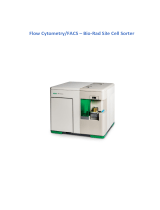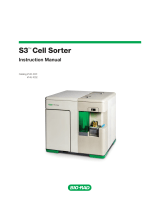Page is loading ...

AccuCheck Counting Beads
Catalog Number PCB100
Pub. No. MAN0005382 Rev. 2.0
WARNING! Read the Safety Data Sheets (SDSs) and follow the handling instructions. Wear appropriate protective eyewear,
clothing, and gloves. Safety Data Sheets (SDSs) are available from thermofisher.com/support.
Product description
AccuCheck Counting Beads are an ecient single-platform method for absolute cell counts that combines the advantages of direct flow
cytometric immunophenotyping with the use of two dierent fluorescent beads (A and B beads). These two fluorospheres are used as
a double internal standard for blood volume calculation. A known volume of AccuCheck Counting Beads is added to the same known
volume of stained blood in a lyse-no-wash technique. The beads are counted along with cells. Since the concentration of beads is
known, the number of cells per microliter (the absolute count) is obtained by relating the number of cells counted to the total number of
fluorescent bead events. The cell number is then multiplied by the number of total fluorospheres per unit of volume.
Beads A and B have been designed such that their unique characteristics allow the determination of whether they have been
homogenously sampled. Bead A is a 6.4 µm sphere that in flow cytometry presents a low forward scatter (FSC) signal, a lower side
scatter (SSC) signal, and emits broadly when excited with a 488 nm argon laser; however, bead A does not fluoresce when excited with
either a 633 nm helium-neon or 635 nm red diode laser. Bead B is a 6.36 µm sphere that presents a low FSC signal, a slightly higher SSC
signal and a higher fluorescent signal when excited with a 488 nm argon laser. Unlike bead A, bead B fluoresces when excited by a longer
wavelength red laser.
Contents and storage
Product Amount Size Storage
AccuCheck Counting Beads 10 mL 100 tests
• 2–8°C
• Do not freeze
• Protect from light
Procedural guidelines
• This method is not aected by the use of dierent lysing
reagents or varying antibody volumes.
• Relevant cells are defined by their immunofluorescence.
• Use a reverse pipetting technique when pipetting samples
and AccuCheck Counting Beads.
• It is recommended that a threshold or discriminator be set
on the fluorescence channel that includes all the positively
stained cells and the two fluorosphere bead clusters.
• At least 1,000 bead events must be acquired to ensure the
accuracy of the assay.
• It is recommended to use samples that are less than 48
hours old.
• The use of cryopreserved samples is not recommended.
Before you begin
• Bring all reagents to room temperature before use.
• Mix samples gently. Do not vortex.
Prepare the sample
1. Prepare the pipette tip for reverse pipetting using sample.
• For dry tip dispensing, press the pipette plunger to the
second stop in sample, then dispense against the dry
round bottom of the test tube until the first pipette stop.
Note: This will leave some residual sample in the pipette tip.
It is recommended that this first sample taken for dispensing
be discarded.
• For wet tip dispensing, draw sample to the second
pipette stop. Do two or three slow dispense cycles at
the first stop, keeping the pipette tip within the sample.
Dispense at the first stop against the lower end of the
wall of the tube.
2. Reverse pipette 100 µl of blood into each tube.
3. To stain cells, add monoclonal antibodies to each tube, mix
gently, then incubate for 10 minutes at room temperature in
the dark.
USER GUIDE
For Research Use Only. Not for use in diagnostic procedures.

4. Add 100 µl of lysing solution to each tube, then vortex.
Note: We recommend using Cal-Lyse™ Lysing Solution (Cat.
No. GAS-010).
5. Incubate for 10 minutes at room temperature in the dark.
6. Add 1 mL of deionized water.
7. Incubate for 5 minutes, then vortex.
8. Mix the AccuCheck Counting Beads by repeated inversion
for 30–45 seconds. Do not vortex.
9. Using the same pipette and reverse pipetting technique
that was used for dispensing the sample, add 100 µL of
AccuCheck Counting Beads to each tube of lysed sample.
10. Cover each sample tube with Parafilm™ film.
11. Immediately before analysis by flow cytometry, mix each
sample thoroughly for 30 seconds.
Prepare flow cytometer
Follow manufacturer's instructions to set up the instrument, then
select a protocol that is compatible with the color combination
used.
1. Set a low value for threshold or discriminator in the FSC
channel, then run an unstained and lysed tube.
Note: No additional modification of FSC and SSC detectors
is needed to acquire the beads. AccuCheck Counting Beads
can be detected on a FSC vs. SSC dot plot, as well as in the
appropriate fluorescence channel.
2. Draw a region on the FSC vs. SSC dot plot that includes
the leukocyte subpopulations and the two fluorescent bead
clusters.
Acquire data
To ensure accuracy, collect a minimum of 1,000 beads while
collecting an appropriate number of cells.
Analyze data
1. Create a gate selecting all beads (type A and type B) on FSC
vs. SSC dot plot (region R1). Display only region R1 on a
FL2/SSC dot plot.
Figure 1 FSC vs. SSC dot plot
Note: A dierent channel should be used if the staining of
cells interferes with bead analysis.
2. Create a new gate (Region R2) to select all beads, making
sure to exclude debris. Display a FL2/SSC dot plot gated on
R1 and R2.
Figure 2 FL2/SSC dot plot
3. Create two new gates (Regions R3 and R4) to select and
dierentiate type A (lower intensity for FL2) and type B
beads (higher intensity for FL2).
Figure 3 Regions R3 and R4 dot plot
2AccuCheck Counting Beads User Guide

4. Verify on the gate statistics table that the proportion of
each type of gated beads agrees with the manufacturer's
indicated proportions.
5. Record the number of total beads and events in regions of
interest for later calculations.
6. Calculate the absolute number of cell population of interest.
= Absolute Count (cells/μL)
˟
Number of AccuCheck
Counting Beads per μL
Number of cells counted
Total number of beads counted
Related products
Catalog numbers that appear as links open the web pages for those products.
Product Cat. No. Amount Size
Cal-Lyse™ Lysing Solution
GAS-010 25 mL 250 tests
GAS-010S-100 100 mL 1000 tests
Limited product warranty
Life Technologies Corporation and/or its aliate(s) warrant their products as set forth in the Life Technologies' General Terms and
Conditions of Sale at www.thermofisher.com/us/en/home/global/terms-and-conditions.html. If you have any questions, please
contact Life Technologies at www.thermofisher.com/support.
Thermo Fisher Scientific | 3747 N. Meridian Road | Rockford, Illinois 61101 USA
For descriptions of symbols on product labels or product documents, go to thermofisher.com/symbols-definition.
The information in this guide is subject to change without notice.
DISCLAIMER: TO THE EXTENT ALLOWED BY LAW, THERMO FISHER SCIENTIFIC INC. AND/OR ITS AFFILIATE(S) WILL NOT BE LIABLE FOR SPECIAL, INCIDENTAL, INDIRECT,
PUNITIVE, MULTIPLE, OR CONSEQUENTIAL DAMAGES IN CONNECTION WITH OR ARISING FROM THIS DOCUMENT, INCLUDING YOUR USE OF IT.
Revision history: Pub. No. MAN0005382
Revision Date Description
2.0 2 February 2022 The manual was updated to follow current style guidelines and to update the manufacturer
address.
1.0 6 October 2011 New Manual for introduction of AccuCheck Counting Beads.
Important Licensing Information: These products may be covered by one or more Limited Use Label Licenses. By use of these products, you accept the terms and conditions of all
applicable Limited Use Label Licenses.
©2022 Thermo Fisher Scientific Inc. All rights reserved. All trademarks are the property of Thermo Fisher Scientific and its subsidiaries unless otherwise specified.
thermofisher.com/support | thermofisher.com/askaquestion
thermofisher.com
2 February 2022
/












